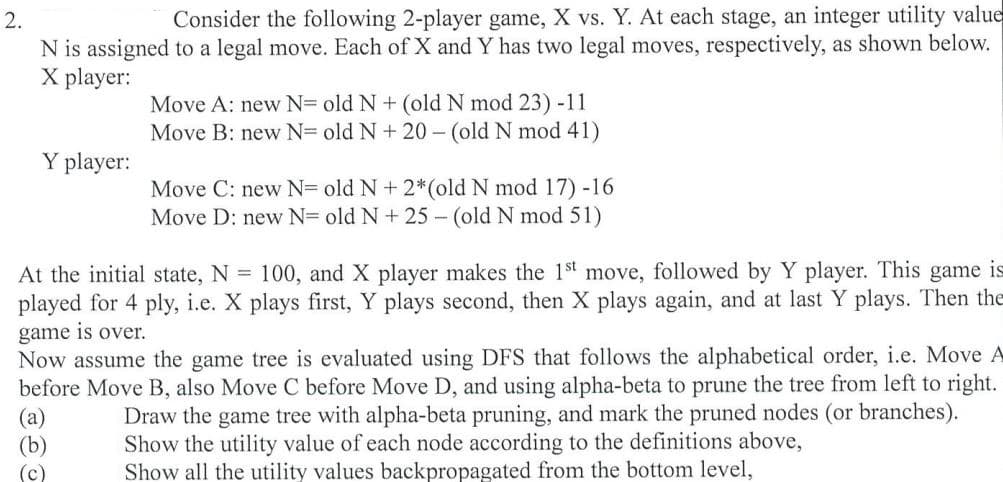Consider the following 2-player game, X vs. Y. At each stage, an integer utility valu N is assigned to a legal move. Each of X and Y has two legal moves, respectively, as shown below. X player: Move A: new N= old N+ (old N mod 23) -11 Move B: new N= old N + 20 (old N mod 41) Y player: Move C: new N= old N+ 2*(old N mod 17)-16 Move D: new N= old N + 25- (old N mod 51) At the initial state, N = 100, and X player makes the 1st move, followed by Y player. This game played for 4 ply, i.e. X plays first, Y plays second, then X plays again, and at last Y plays. Then th game is over. Now assume the game tree is evaluated using DFS that follows the alphabetical order, i.e. Move before Move B, also Move C before Move D, and using alpha-beta to prune the tree from left to right (a) (b) Draw the game tree with alpha-beta pruning, and mark the pruned nodes (or branches). Show the utility value of each node according to the definitions above, 11 th the hottom level
Consider the following 2-player game, X vs. Y. At each stage, an integer utility valu N is assigned to a legal move. Each of X and Y has two legal moves, respectively, as shown below. X player: Move A: new N= old N+ (old N mod 23) -11 Move B: new N= old N + 20 (old N mod 41) Y player: Move C: new N= old N+ 2*(old N mod 17)-16 Move D: new N= old N + 25- (old N mod 51) At the initial state, N = 100, and X player makes the 1st move, followed by Y player. This game played for 4 ply, i.e. X plays first, Y plays second, then X plays again, and at last Y plays. Then th game is over. Now assume the game tree is evaluated using DFS that follows the alphabetical order, i.e. Move before Move B, also Move C before Move D, and using alpha-beta to prune the tree from left to right (a) (b) Draw the game tree with alpha-beta pruning, and mark the pruned nodes (or branches). Show the utility value of each node according to the definitions above, 11 th the hottom level
Computer Networking: A Top-Down Approach (7th Edition)
7th Edition
ISBN:9780133594140
Author:James Kurose, Keith Ross
Publisher:James Kurose, Keith Ross
Chapter1: Computer Networks And The Internet
Section: Chapter Questions
Problem R1RQ: What is the difference between a host and an end system? List several different types of end...
Related questions
Question
100%
[9_2]
Please answer this question step by step

Transcribed Image Text:2.
Consider the following 2-player game, X vs. Y. At each stage, an integer utility value
N is assigned to a legal move. Each of X and Y has two legal moves, respectively, as shown below.
X player:
Move A: new N= old N + (old N mod 23)-11
Move B: new N= old N+ 20 - (old N mod 41)
Y player:
Move C: new N= old N + 2*(old N mod 17) -16
Move D: new N= old N+ 25 - (old N mod 51)
At the initial state, N = 100, and X player makes the 1st move, followed by Y player. This game is
played for 4 ply, i.e. X plays first, Y plays second, then X plays again, and at last Y plays. Then the
game is over.
Now assume the game tree is evaluated using DFS that follows the alphabetical order, i.e. Move A
before Move B, also Move C before Move D, and using alpha-beta to prune the tree from left to right.
(a)
(b)
(c)
Draw the game tree with alpha-beta pruning, and mark the pruned nodes (or branches).
Show the utility value of each node according to the definitions above,
Show all the utility values backpropagated from the bottom level,

Transcribed Image Text:A partial sample game tree with the top two levels is shown below for your reference. The numbers in
the boxes are the values of N. You need to finish the rest of the game tree, and backpropagate the
appropriate N values. Show the backpropagated N values next to the boxes, e.g. No, N1, N2.
No
100
A
N1
97
102
N2
Expert Solution
This question has been solved!
Explore an expertly crafted, step-by-step solution for a thorough understanding of key concepts.
This is a popular solution!
Trending now
This is a popular solution!
Step by step
Solved in 3 steps with 1 images

Recommended textbooks for you

Computer Networking: A Top-Down Approach (7th Edi…
Computer Engineering
ISBN:
9780133594140
Author:
James Kurose, Keith Ross
Publisher:
PEARSON

Computer Organization and Design MIPS Edition, Fi…
Computer Engineering
ISBN:
9780124077263
Author:
David A. Patterson, John L. Hennessy
Publisher:
Elsevier Science

Network+ Guide to Networks (MindTap Course List)
Computer Engineering
ISBN:
9781337569330
Author:
Jill West, Tamara Dean, Jean Andrews
Publisher:
Cengage Learning

Computer Networking: A Top-Down Approach (7th Edi…
Computer Engineering
ISBN:
9780133594140
Author:
James Kurose, Keith Ross
Publisher:
PEARSON

Computer Organization and Design MIPS Edition, Fi…
Computer Engineering
ISBN:
9780124077263
Author:
David A. Patterson, John L. Hennessy
Publisher:
Elsevier Science

Network+ Guide to Networks (MindTap Course List)
Computer Engineering
ISBN:
9781337569330
Author:
Jill West, Tamara Dean, Jean Andrews
Publisher:
Cengage Learning

Concepts of Database Management
Computer Engineering
ISBN:
9781337093422
Author:
Joy L. Starks, Philip J. Pratt, Mary Z. Last
Publisher:
Cengage Learning

Prelude to Programming
Computer Engineering
ISBN:
9780133750423
Author:
VENIT, Stewart
Publisher:
Pearson Education

Sc Business Data Communications and Networking, T…
Computer Engineering
ISBN:
9781119368830
Author:
FITZGERALD
Publisher:
WILEY